The druids were an ancient class of people within Celtic cultures. They were counted as scholars, priests, and judges. To the societies they served, their insight was deemed invaluable.
Leading up to the Gallic Wars (58-50 BCE), the druids were fiercely outspoken against Roman rule and became a thorn in the Empire’s side.
Table of Contents
Druid Religion

Druidism was primarily widespread among the Celtic tribes of ancient Britain, Ireland, and Gaul. Over time, its influence spread through parts of Western Europe before the Roman expansion. The druid religion, called Druidry (or Druidism), is believed to have been a shamanic religion. Druids would have been responsible for harvesting medicinal herbs used to treat various ailments. Likewise, it was thought they acted as mediators between the natural world and humanity.
Outside of communing with nature, worshiping the Celtic pantheon, and fulfilling the many other roles they had, the druids were also said to tell fortunes. An important stepping stone in Druidry was the practice of divination and augury. Additionally, Christian monks believed the druids were able to wield the power of nature to their benefit (i.e., creating dense fog and summoning storms).
READ MORE: 16 Celtic Gods and Goddesses: Ancient Celtic Pantheon
Druid beliefs are difficult to pin down since there are few records of their personal beliefs, philosophies, and practices. What is known about them comes from second (or even third) hand accounts from the Romans and the Greeks. It also doesn’t help that the Roman Empire kind of hated the druids, as they were acting in opposition to the Roman conquest of Celtic lands. So, most accounts of the druids are somewhat biased.
You see, the druids outlawed written accounts of their practices. They strictly adhered to oral traditions, though they did have extensive knowledge of the written language and were all literate. They simply didn’t want their sacred beliefs to fall into the wrong hands, which means that we have no reliable account detailing druidic practice.
There are accounts that cite that druids believed the soul was immortal, residing in the head until it was reincarnated. Theories state this would create a tendency for druids to decapitate those who have passed and keep their heads. Now, with the loss of the druidic oral tradition, we will never quite know the exact beliefs druids held about the soul. On that note, this sounds somewhat like what befell the Norse god, Mimir, whose head was kept by Odin for the wisdom it retained.
READ MORE: Norse Gods and Goddesses: The Deities of Old Norse Mythology
Druid Gods
The druids apparently worshiped many of the gods found within Celtic mythology, both major and minor, as well as ancestors. They would have certainly venerated the Celtic goddess Danu and the Tuatha Dé Danann. In fact, legends say it was four celebrated druids who crafted the Tuatha Dé Danann’s four great treasures: the Cauldron of the Dagda, the Lia Fáil (Stone of Destiny), the Spear of Lugh, and the Sword of Nuada.
Druid Symbols
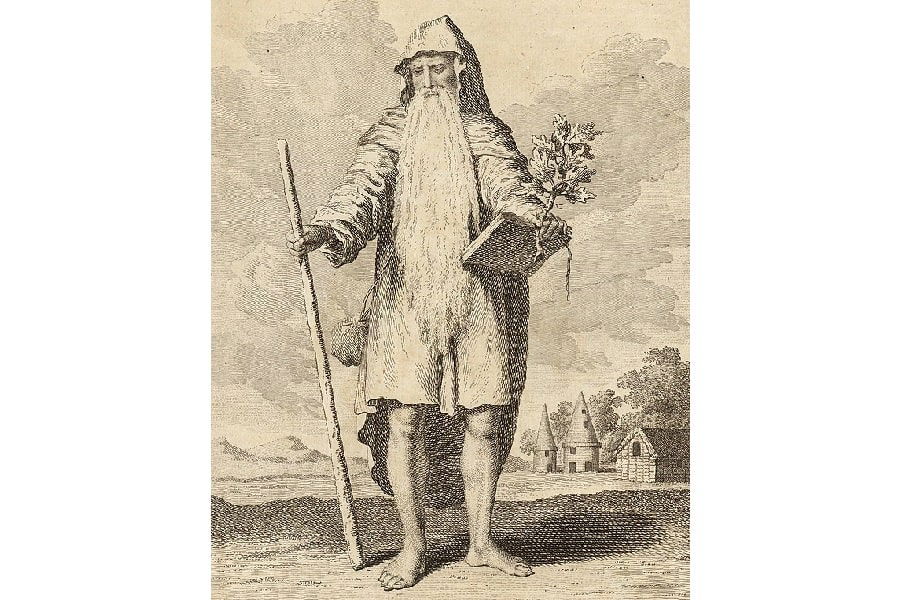
The symbols used by the druids in their religious and ceremonial practices carry deep meanings and connections to the natural world and the cosmos. These symbols, often derived from their observations of nature and the universe, played a significant role in their rituals, storytelling, and spiritual beliefs.
Mistletoe and the Moon
Mistletoe held a special place in druidic lore and was considered a potent symbol of life and fertility. Druids revered mistletoe, especially when it grew on oak trees, which they saw as sacred. The harvesting of mistletoe was a ceremonial act performed with great reverence, usually at the time of the winter solstice, which marked the rebirth of the sun. The druids believed mistletoe to have healing properties and used it in rituals to symbolize the eternal cycle of life and death, reflecting the regeneration of nature.
The moon, too, was central to druidic beliefs and practices. As a celestial body that governed the night and was closely linked to the cycles of nature, the moon was a powerful symbol of change, transition, and the feminine aspect of the divine. Druidic ceremonies often aligned with the phases of the moon, using its light to enhance the magical properties of rituals. The moon’s cyclical journey through the skies mirrored the druidic understanding of the cycles of life, death, and rebirth, emphasizing the interconnectedness of all things.
Druids and Stonehenge
Stonehenge, with its massive standing stones arranged in a complex pattern, has long been associated with the druids, although it predates them by thousands of years. Despite this, it’s believed that the druids may have used Stonehenge or similar sites for their ceremonies, particularly those related to astronomical events. The alignment of Stonehenge with the solstices suggests a deep understanding of celestial movements and their significance in druidic rituals.
READ MORE: 7 Wonders of the Ancient World: Great Pyramid of Giza, Statue of Zeus, and More!
This ancient site embodies the druidic fascination with the heavens and the earth, serving as a testament to their advanced knowledge of astronomy and geometry.
The precise placement of the stones, allowing for specific solar and lunar alignments, underscores the importance of harmonizing human activities with the natural and cosmic cycles. Although the direct connection between druids and Stonehenge remains a topic of debate, the site continues to be an avatar of ancient science.
Teaching and Practice
The teaching and practice of Druidism are diverse and adaptable, reflecting the individual beliefs, experiences, and interpretations of practitioners. At its core, Druidism encourages a profound reverence for nature, a commitment to personal growth and learning, and a sense of interconnectedness with all living beings.
Practicing Human Sacrifice
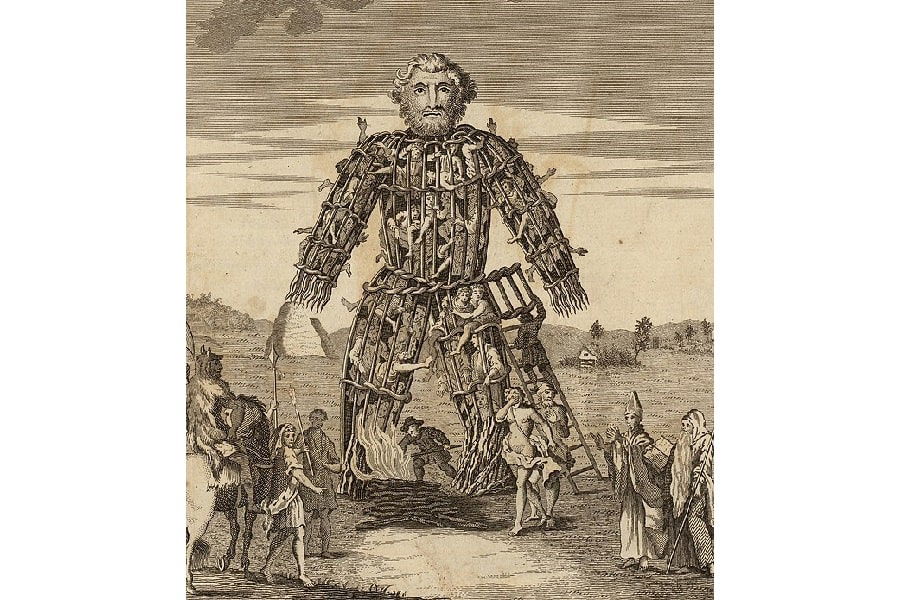
The characterization of druids as “good” or “evil” oversimplifies their complex role in ancient societies; they were revered spiritual leaders, educators, and advisors in Celtic culture, but Roman accounts often portrayed them negatively due to cultural and military conflicts.
READ MORE:Ancient Civilizations Timeline: The Complete List from Aboriginals to Incans
However, one interesting – and, granted, macabre – practice that the Romans noted the druids practiced is human sacrifices. They had described a huge “wicker man” that would hold human and animal sacrifices, which would then be burned. Now, this is a stretch. While we don’t exactly know the druidic beliefs on life and death, the sensational depictions of their apparent human sacrifices could be chalked up to archaic propaganda.
In ancient times, human sacrifices weren’t unusual; though, the tales that the soldiers of the Roman army returned home with regarding the druids didn’t cast them in the most flattering light. From Julius Caesar to Pliny the Elder, Romans did the utmost to describe the druids as both cannibals and ritual murderers. By barbarizing Gallic society, they gained rampant support for their series of invasions.
In all, there is a chance that the druids did in fact partake in human sacrifice under certain circumstances. Some suggest that sacrifices would take place to save someone going off to war or someone suffering from a deadly illness. There have even been theories that the most famous bog body, Lindow Man, was brutally killed in the British Isles as a druidic human sacrifice. If it were the case, he would have been sacrificed around Beltane, likely on the heels of the Roman invasion; he had consumed mistletoe at some point, something Caesar’s druids used often.
Druidry and Other Paths
Druidry, as a spiritual path, often intersects with various other traditions and practices. Unlike the singular approach of many religious practices, druidic society was inclusive, absorbing elements from Celtic culture, pre-Christian rituals, and even later influences from Christian traditions like those associated with Saint Patrick. This synthesis of beliefs showcases druids’ roles not just as religious leaders but as bridges between different spiritual practices.
READ MORE: How Did Christianity Spread: Origins, Expansion, and Impact
The revival of the druid in modern times further highlights this blend, as neo-druids incorporate contemporary spiritual practices with ancient traditions. Through the oral tradition, essential Celtic lore and knowledge were preserved, allowing druids to serve as custodians of both their own traditions and the wisdom of other paths.
In their role as mediators between the human and natural worlds, druids emphasized the significance of the natural environment in spiritual life. The celebration of the summer solstice and spring equinox reflects their deep connection to the Earth’s cycles, a practice shared with other pagan and earth-centered religions. This connection to nature, along with the reverence for sacred sites and standing stones, shows the druids’ commitment to understanding and preserving the harmony between humanity and the natural world. The archaeological evidence of such sites supports the written language accounts by Roman writers, offering a glimpse into the druids’ practices and their shared beliefs with other ancient spiritual paths.
Furthermore, druids played a crucial role in the oral tradition, ensuring the transmission of stories, laws, and historical records.
Female Druids
Female druids were called bandruí.
The attire of bandruí was similar to that of male druids, with the main distinction being the wearing of pleated skirts instead of trousers. For ceremonial purposes, these women were often veiled, a practice that might have extended to men as well. This veiling could signify a spiritual separation from the mundane to the sacred, highlighting the importance of druids in conducting religious practices and rites. The archaeological evidence and classical writers, including some Roman writers, offer glimpses into these practices, albeit limited and often from an external viewpoint.
During conflicts with the Roman soldiers, notably, the bandruí would don all-black attire, channeling figures from Irish mythology such as the Badb Catha or Macha. This choice of color and the invocation of such powerful mythological entities suggest that the bandruí were not only spiritual leaders but also wielded considerable influence and respect in Celtic culture and druidic society. Their participation in battles, clad in black, was likely a psychological tactic as much as a spiritual statement, evoking fear and reverence in friends and foes alike.
The role of female druids in Celtic lore and spiritual practice was undoubtedly significant, though much of their history remains shrouded in mystery due to the oral tradition of the Celtic druids and the biases of Greek and Roman writers.
Julius Caesar’s Descriptions of the Druids
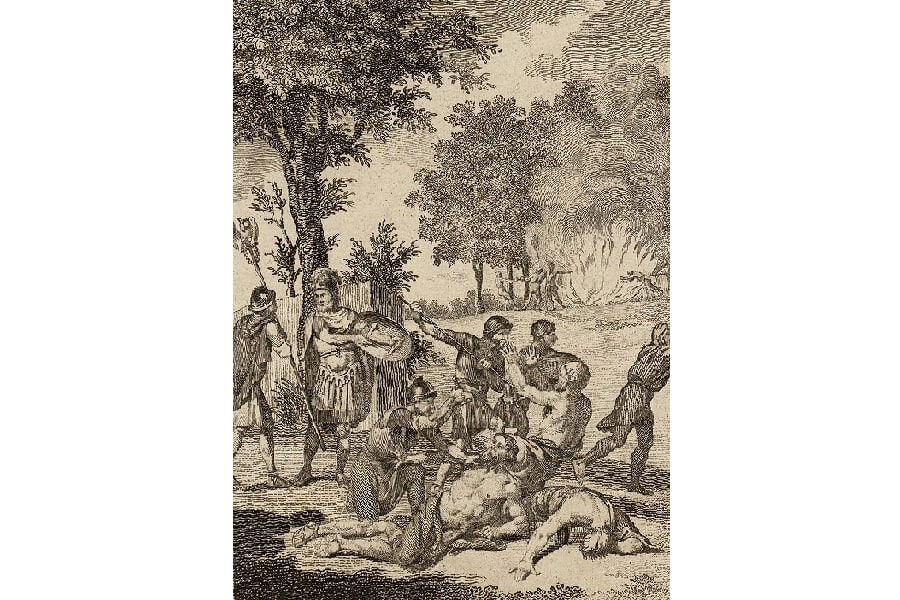
The writings of Julius Caesar, particularly those detailing the lives and practices of the druids, are primarily found in his work “Commentarii de Bello Gallico” (Commentaries on the Gallic War). Written by Caesar between 58 and 50 BCE, this collection serves as a firsthand account of his military campaigns in Gaul, now modern-day France. It is in these written language texts that Caesar offers a rare glimpse into Celtic druid society from the perspective of a Roman general. These documents are among the earliest known records of druids, providing valuable insights into their roles, beliefs, and spiritual practices.
Modern interpretations of Caesar’s work, such as those published by Oxford University Press and research conducted by academics at institutions like Cardiff University, have helped to contextualize and analyze his accounts.
If we listen to Julius Caesar, the druids were the go-to for anything and everything regarding religion. As a religious, learne, and united class, the druids were also not required to pay taxes – something that Caesar notes the appeal of. That being said, the druids were much more than a religious caste. They were prominent figures that did just about everything.
Below is a quick list of the roles that druids filled in Celtic society:
- Priests (surprise)
- Socialites
- Judges
- Historians
- Teachers
- Scribes
- Poets
Druids would have been extremely well-versed in Celtic mythology. They would have known the Celtic gods and goddesses like the back of their hands. Effectively, they were their people’s lore keepers, having mastered their histories, both real and legendary.
It should also be noted that the druids, while they had many roles, also commanded immense respect. Their opinions were valued. While they weren’t necessarily the chiefs of their tribes, they had enough sway that they could have someone banished with a single word. It is for that reason that the Romans were at such a standstill when it came to dealing with the druids.
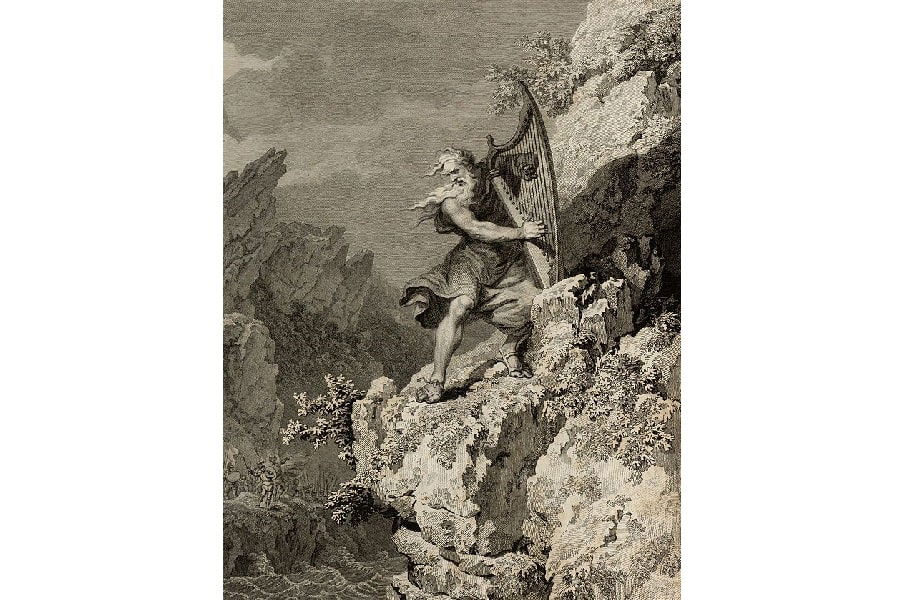
Druid Lore
Druids come from the British Isles and areas of Western Europe. Druidry was thought to have gotten its start in modern Wales sometime before the 4th century BCE. Some classical writers go as far as to say that Druidry dates back to the 6th century BCE. However, thanks to the lack of knowledge about druids, we can’t say for certain.
The druids were neither Irish nor Scottish. Rather, they were Britons (a.k.a. Brythons), Gauls, Gaels, and Galatians. These were all Celtic-speaking peoples and thus considered Celts. Druids were a part of Celtic societies and can’t be summed up as being either Irish or Scottish.
The druids were a significant part of ancient Celtic religion, as well as Celtic and Gallic cultures. Druids were not their own race. A “druid” was a title that would have been given to those belonging to a high-ranking social class.
The Meaning of the Word “Druid” in Gaelic?
The word “druid” may roll off the tongue, but no one quite knows the etymology behind it. Most scholars agree that it may have something to do with the Irish-Gaelic “doire,” which means “oak tree.” The oak has great significance in many ancient cultures. Usually, they represent abundance and wisdom.
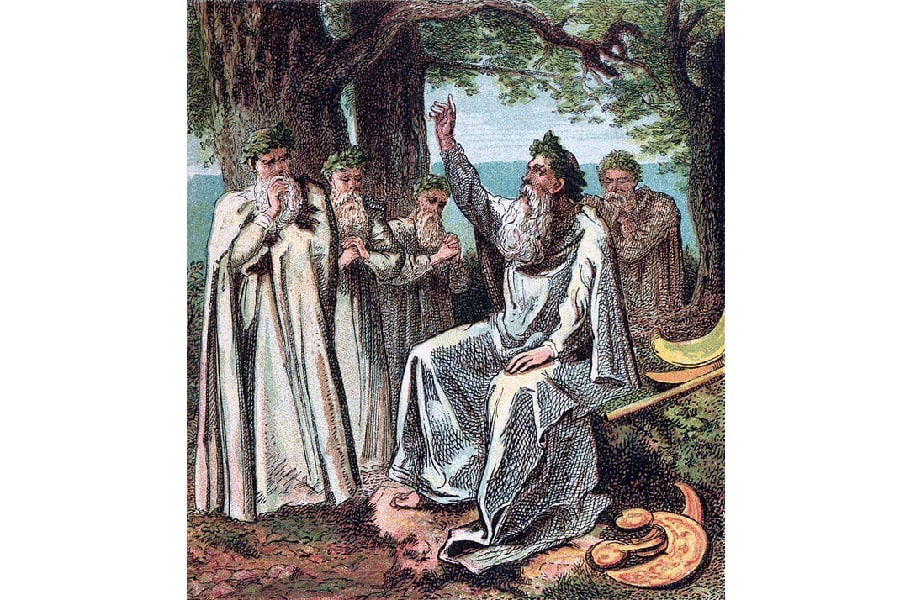
To Roman historian Pliny the Elder, the druids – whom he called “magicians” – held no tree in as high regard as they did oaks. They treasured mistletoe, which could make barren creatures fertile and cure all poisons (according to Pliny).
Also, the druids’ relationship with oaks and the mistletoe that thrives off of them may be a bit exaggerated. They revered the natural world, and the oak may have been particularly sacred. However, we lack any substantial evidence that what Pliny the Elder said is true: he lived past the time that Druidry would have been widely practiced. Despite this, “druid” does appear to originate from the Celtic word for “oak,” so…maybe there is something there.
Druids’ Abode
The druids were all over the place, and not necessarily because they were so busy. They were, but that’s beside the point. The druids were active throughout various Celtic territories and ancient Gaul, including modern Britain, Ireland, Wales, Belgium, and parts of Germany. They would have belonged to specific tribes from which they likely hailed ancestry.
We’re not really sure if druids would have had a separate living space away from the rest of their respective tribes, such as a Christian convent. Given their active role in society, they likely lived amongst the general populace in round, conical homes. A New Edition of Toland’s History of the Druids notes that the homes, often suited for a single resident, were called “Tighthe nan Druidhneach,” or “Druid Houses.”
Unlike the dated belief that the druids lived in caves or were just wild men in the woods, the druids did live in homes. They met in sacred groves, however, and were thought to have built stone circles as their very own “Temples of the Druids.”
The Appearance of Druids
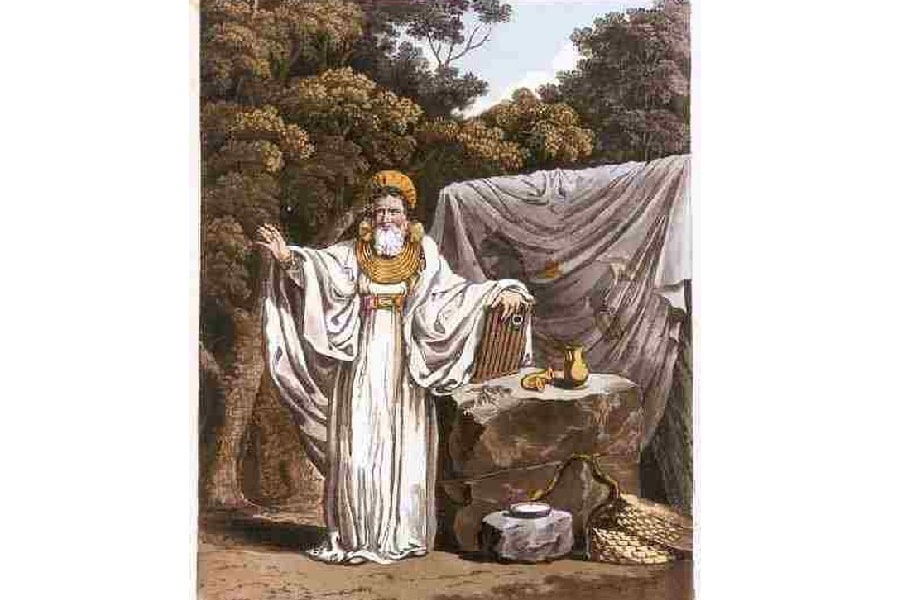
If you search for images of druids, you’ll be getting tons of images of bearded men in flowing white robes hanging in the woods with other bearded men in white robes. Oh, and laurels of mistletoe would have graced the head of everybody present. Not all druids looked like this or dressed that way.
The descriptions of how druids looked are primarily from Greco-Roman sources, though we have some sprinklings in Celtic myths as well. It’s thought that druids would wear white tunics, which were likely knee-length and not cascading robes. Otherwise, many druids had the nickname mael, which meant “bald.” That means that druids probably kept their hair in a tonsure that made their foreheads seem large, like a faux receding hairline.
However, what a druid priest would wear depends on what role they had. At any given time, a druid would have a polished and gilded wooden staff on hand that signified the office they held.
Their tunic and cloak were primarily white, as Pliny the Elder had described their all-white vestments as they gathered mistletoe. If not made of fabric, their cloaks would have been made of a light bull hide, either white or gray in color. The poets (filídh) that emerged from the priestly caste after Roman occupation were noted as wearing feathered cloaks. The feathered fashion could have survived from the earlier druids, though this remains to be speculation.
Some druids would have also donned headdresses made of bird feathers, though not on a day-to-day basis. Bronze sickles were used to collect medicinal herbs. However, they did not regularly wield sickles. They weren’t an indication of office, as far as historians are aware.
Men would likely have worn some impressive beards, as was the style for the men of Gaul since there was no account of them having gone baby-faced or bearded. They also probably had some long sideburns.
The End of Druidism
The decline of ancient Druidism wasn’t a swift downfall but rather a gradual fading influenced by the Roman conquest and the spread of Christianity across Celtic lands. The Romans, under leaders like Julius Caesar, viewed the Druids with a mixture of fascination and fear, partly due to their significant influence within Celtic society and their practices, which included rituals that were alien and sometimes abhorrent to Roman sensibilities, such as human sacrifice. Roman policies aimed at weakening the Druids’ power, including bans on their practices and the integration of the Celtic territories into the Roman Empire, significantly diminished their influence.
As Christianity began to spread in the first few centuries AD, it encountered a deeply rooted Druidic tradition in the Celtic regions. The new religion, with its organized structure and monotheistic doctrine, offered a stark contrast to the polytheistic, nature-centric belief system of the Druids. Saints like Patrick, who is credited with converting Ireland to Christianity, directly challenged Druidic authority and practices, symbolizing the struggle between the old and new beliefs. The Christian church’s systematic approach to eradicating pagan practices involved repurposing many Druidic sites and festivals into Christian ones, thereby weakening the Druids’ hold on the people.
By the end of the first millennium AD, Druidism had largely disappeared as a practiced religion, surviving only in legends, folklore, and the occasional practices disguised as folk traditions to avoid Christian persecution.
Druids Today
Like many pagan practices, Druidry still exists. One can say there was a “druid revival” that began around the 18th century, emerging from the Romanticism Movement. Romantics of the era celebrated nature and spirituality, building blocks that eventually reignited interest in ancient Druidry.
Not quite like Celtic druids, modern druidism places an emphasis on nature-centered spirituality. Moreover, modern druidism does not have a set of structured beliefs. Some practitioners are animists; some are monotheistic, some are polytheistic, and so on and so forth.
Moreover, modern Druidry has its own unique druid systems that are within their respective orders. Unlike the ancient Gallic druid, the druids of today have their own personal interpretations of the divine. There are monotheistic druids – whether they believe in an all-encompassing god or goddess – and polytheistic druids.
Without being able to train as an Iron Age druid (which could have taken anywhere from 12-20 years) and learn directly from the source, modern druids have been left to find their own path. They may perform private sacrifices and stage public rituals, such as the Summer and Winter Solstice celebrations held at Stonehenge. Most druids have an in-home altar or shrine. Many have further conducted worship in natural spaces, such as a forest, near a river, or in stone circles.
Nature and its veneration are two mainstays of Druidry that have survived the centuries. Just as the ancient druids considered this sacred, the modern druid finds the same things sacred.
References
Piggott, Stuart. “The Druids and Stonehenge.” The South African Archaeological Bulletin, vol. 9, no. 36, 1954, pp. 138–40. JSTOR, https://doi.org/10.2307/3886827. Accessed 21 Mar. 2024.
DeWitt, Norman J. “The Druids and Romanization.” Transactions and Proceedings of the American Philological Association, vol. 69, 1938, pp. 319–32. JSTOR, https://doi.org/10.2307/283182. Accessed 21 Mar. 2024.
von Pfluck-Harttung, Julius. “The Druids of Ireland.” Transactions of the Royal Historical Society, vol. 7, 1893, pp. 55–75. JSTOR, https://doi.org/10.2307/3678181. Accessed 21 Mar. 2024.
https://press.uchicago.edu/ucp/books/book/distributed/R/bo125520734.html
https://academic.oup.com/yale-scholarship-online/book/16253
Sharon, Avi. “The Oak and the Olive: Oracle and Covenant.” SiteLINES: A Journal of Place, vol. 13, no. 2, 2018, pp. 3–4. JSTOR, http://www.jstor.org/stable/26395073. Accessed 21 Mar. 2024.
Lewis, A. L. “44. Modern Druids in Wales.” Man, vol. 7, 1907, pp. 70–72. JSTOR, https://doi.org/10.2307/2787169. Accessed 21 Mar. 2024.
Last, Hugh. “Rome and the Druids: A Note.” The Journal of Roman Studies, vol. 39, 1949, pp. 1–5. JSTOR, https://doi.org/10.2307/297701. Accessed 21 Mar. 2024.